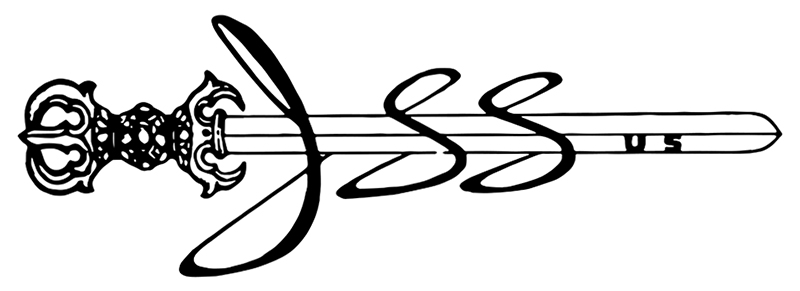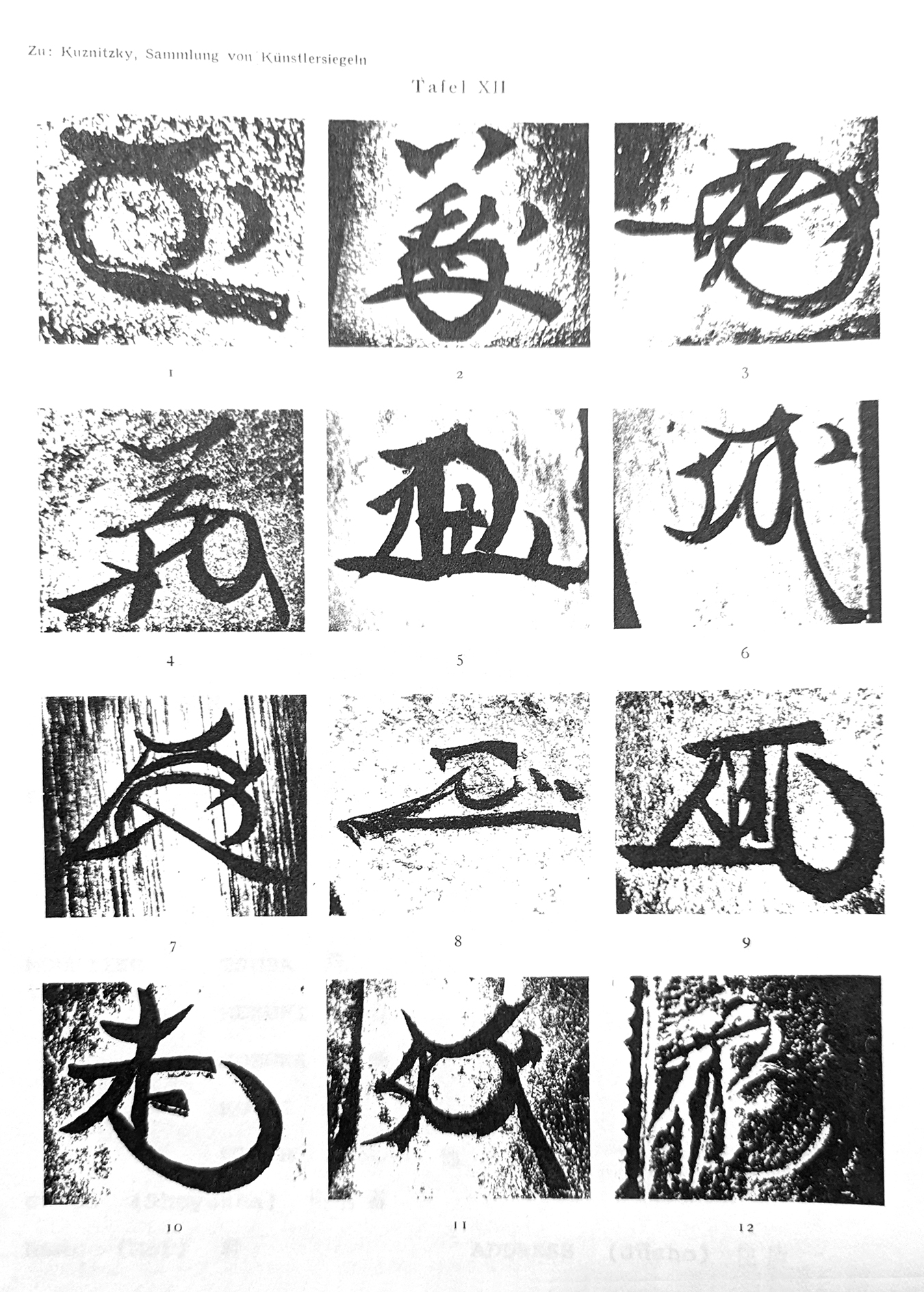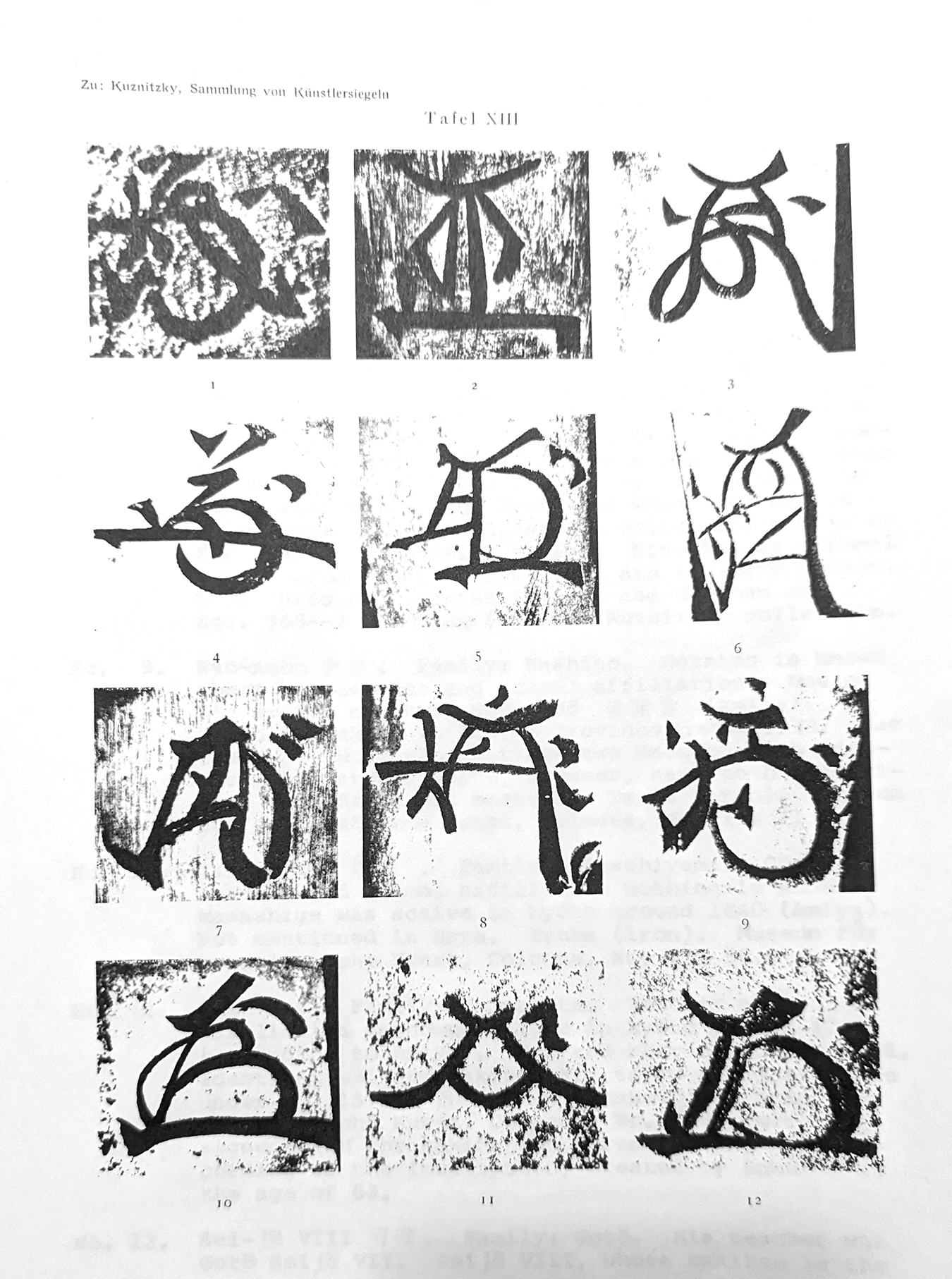
The articles on this page originally appeared in JSSUS newsletter Volume 8, no.2, 1970. Page 46
A Collection of Artists Seals (Han and Kakihan)
in Microphotographic Reproduction
by Martin Kuznitzky, translated from the German by Alan L. Harvie.
A Collection of Artists Seals (Han and Kakihan)
in Microphotographic Reproduction
by Martin Kuznitzky, translated from the German by Alan L. Harvie.

No. 1 Nao-kazu.Family: Toda. Nothing is known about his teacher and school affiliation. Artist name: Tekisai. Lived in Kashiwazaki in the province of Echigo. The guard (iron), whose kakihan is reproduced by No 1 of this plate, was made, according to the dating, in the fall of 1870. For the description of this guard see Hara, p. 143. Staatliche Museen, Berlin, No. 2485.
No. 2. Yoshi-nori. Family: Seki. Cf. the microphotograph of Plate II, No. 1. The difference between these two kakihan is accounted for by their deriving from different working periods of the Master. In these the change of his "handwriting," otherwise unaltered in its characteristic features, becomes evident. The dating of the handle says: "completed as an old man 71 years of age on a lucky day of the first month of spring of the third year of the Meiji era" (1870). Kozuka (shakudo). Kuznitzky collection.
No. 3. Yu-sai. Family: Wada. Through his teacher, Gotō Ichijo, he belongs to the Ichijo School. On the kozuka, signed with the reproduced kakihan, the names Yusai and Gekkindo (Getsu-kin-do) are cursively inscribed. Transcription (according to Amiya). Can be found in Hara under Isshin, p. 37.Kozuka (shakudo). Fahrenhorst collection, No. 6.
No. 4. Yoshi-hide. Family: Sonobe. Cf. Hara, p. 243. Tsuba (shibuichi). See Mosle under Nos. 1496 to 1499 for reproductions of identical meiji and kakihan. Staatliche Museen, Berlin, Case 69.
No. 5. Hiro-chika. Belongs to the Mito School. According to Amiya his teacher was Hirotoshi (Hara says: Hiro- naga). For the rest cf. Hara, p. 26. Joly also quotes the names Seiunsai and Ichijiusai Residence: Edo. His principal work, according to Amiya, was in the Ansei era (1854--1860). Tsuba Bow (bronze). Kuznitzky collection.
No.6 Masa-taka. Family: Tsuji. Cf. Hara, p. 88. The kakihan portrayed by Mosle under No. 1367, while fairly well resembling our microphotograph, Plate XII, No. 6, shows distinct deviations in details.. Fuchi (shakudo). Museum für ostasiatische Kunst, Cologne, No. 35.
No. 7. Tsune-mitsu I. Family: Kikuchi. Belongs to the Yokoya school. His teacher was Kikuchi Tsunekatsu. Cf. Hara, p. 227. Kozuka (shakudo). Kuznitzky collection.
No. 8. Tsune-masa Family: Goto. Student of Goto Seijo. Tsunemasa lived in Kii Province around 1780 (Amiya). Not mentioned by Hara. This Tsunemasa is listed with his kakihan by Joly on p. 115 under No. 421. Joly, on p. 115 under No. 418, lists the contemporary (Temmei era) of the same name whose kakihan is reproduced on Plate VI,
No. 8. In contrast to Plate XII, No. 8, the Tsunemasa whose kakihan is represented by Plate VI, No. 8, writes the character for "Tsune" in cursive script. Nonetheless, Kümmel considers it possible that they are the same person. Mosle presents identical meiji and kakihan under Nos. 368--370. Tsuba (iron). Kuznitzky collection.
No. 9. Nao-nobu. Family: Kashino. Nothing is known about his teacher and school affiliation. One of his artist names is Seisendo (Amiya). He lived in Takada in Echigo Province around 1830. Not listed by Hara who mentions two Naonobu with iden- tical signatures which, however, have to be associated with different masters. Tsuba (iron). Museum für ostasiatische Kunst, Cologne, No. 11. 71.
No. 10. Masa-shige I. Family: Higashiyama. of his teacher and school affiliation nothing is known. Masashige was active in Kyoto around 1840 (Amiya). Not mentioned in Hara. Tsuba (iron). Museum für ostasiatische Kunst, Cologne, No. 11. 56.
No. 11. Boku-sen. Family: Yamashita. Teacher and school affiliation unknown. Lived in Kyoto around 1730 (according to Amiya). For the rest cf. Hara, p. 6. Identical mei and kakihan are to be found in Mosle under No. 1379. The guard (shakudo), Museum für ostasiatische Kunst, Cologne, No. 300, which is signed with the kakihan here reproduced, was, ac- cording to the inscription, created by Bokusen at the age of 63.
No. 12. Sei-jo VIII. Family: Goto. His teacher was Goto Seijo VII. Seijo VIII, whose kakihan is the one reproduced here, also called himself (according to Amiya) Rihei. Not mentioned by Hara. (iron), Kuznitzky collection, from which the kakihan derives, like all creations of this family branch The guard (according to Hara), is not executed in characteristic Goto style.

PLATE XIII
No. 1. Naga-yoshi. Family: Ichinomiya. Student of NagaTsune. Also signed with the names Kenryushi (on the guard from which the reproduced kakihan is taken) and Gikoshi. Figure 1284 in Mosle has similar mei and similar kakihan. For the rest see Hara, p. 139. Tsuba (iron). Museum für ostasiatische Kunst, Co- logne, No. 10. 29.
No. 2. Toshi-haru #. Family: Suzuki. His teacher was Toryusai Kiyotoshi (Amiya). Artist name: Juryūsai. Active in Edo about 1830. Not mentioned by Hara. Kozuka (shakudo). Kuznitzky collection.
No. 3. Tsune-katsu. Family: Kikuchi (previously Konishi). Cf. Hara, p. 227. Mosle reproduces identical mei and kakihan in Nos. 1197 and 1198. Tsuba (shakudo). Museum für ostasiatische Kunst, Cologne, No. 330.
No. 4. Mitsu-yoshi . Family: Kikugawa. His teacher was Kikugawa Hidemitsu (Amiya). Mitsuyoshi lived in Mito and worked mainly about 1830. Not mentioned by Hara. Tsuba (shakudo). Museum für ostasiatische Kunst, Cologne, No. 319.
No. 5. Tomo-yasu. Family: Kikugawa. Nothing is known of his teacher. He lived in Mito and worked chiefly around 1830 (Amiya). Not mentioned by Hara. Fuchi (shakudo). Museum für ostasiatische Kunst, Cologne, No. 72.
No. 6. Shō-ho E. Family: Muto. Through his teacher Kon- kwan he belongs to the Iwamoto School. The kakihan is derived from the fuchi (shakudo) No. 10. 6 of the Museum für ostasiatische Kunst, Cologne. Note: This artist is listed as Masatoshi by Hara in the 2nd edition of his book (Die Meister….)page 91. (Mosle in No. 1428 also lists him as Masa-toshi.) However, Amiya mentions the most common reading under which this Master is known in Japan: Shoho.
No. 7. Hide-masa. Family: Omori. Student of Teru hide. He lived in Edo and worked mainly around 1780. Not mentioned by Hara. Kozuka (iron). Kuznitzky collection.
No. 8. Mitsu-haru . Nothing is known about the family and school affiliation of this artist (Amiya). From the appearance of the guard (Kuznitzky collection) Amiya concludes that it was created in the Meiji era (circa 1870). However, from the difference of their residences it becomes apparent that this Mitsuharu is, in spite of the same working period, not identical with the Master listed by Hara, p. 103, who used the same signature for his name. The Mitsuharu of Plate XIII, No. 8, states on the guard: To dai roku: roku = at the foot of a hill; To dai, a hill situated in Tokyo and now commonly called "Ueno. That is to say Tokyo, while the Mitsuharu listed by Hara lived in Kanazawa in Kaga Province.
No. 9. Yasu-yoshi. Family: Nukagawa. Amiya gives Mito as his residence (in contrast to Hara). For the rest cf. Hara, p. 237. Fuchi (iron). Museum für ostasiatische Kunst, Cologne, No. 16.
No. 10. Haru-nobu. Nothing is known about teacher and family although Harunobu still lived in Edo in 1860, not earlier than 70 years ago. Not mentioned in Hara. The swordguard (shakudo) shows, in deep, broad engraving, bamboo branches after a painting by Bunchō, whose name Harunobu has engraved in the framing of the guard. Kuznitzky collection.
No. 11. Sei-sai E. Family: Hashimoto. Nothing is known about his teacher. He lived in Edo about 1830 (Amiya). Not to be found in Hara. Joly lists the Master as Masanari and, on page 46 under No. 157, reproduces the identical kakihan. Tsuba (iron). Kuznitzky collection.
No. 12. Hiro-nao. Nothing is known about his family. Active in Mito about 1830 (Amiya). Cf. Hara, p. 28. Tsuba (iron). Staatliche Museen, Berlin, Case 69.